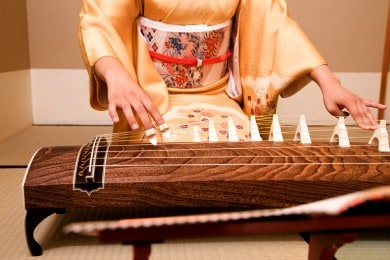Welcome to the captivating world of the Hirajoshi scale, a unique and enigmatic musical scale with origins deeply rooted in Japanese music.
In this comprehensive guide, we will embark on a fascinating journey to unravel the secrets of this pentatonic scale and explore its rich history, intervals, and applications in both traditional and contemporary music.
Whether you’re a seasoned musician or a curious music enthusiast, this article will provide you with valuable insights and practical knowledge about the Hirajoshi scale’s theory, harmony, and use in compositions.
Hirajoshi: A Brief History
The Hirajoshi scale finds its roots in ancient Japanese shamisen music, originally developed for tuning the traditional Koto instrument.
While technically a tuning rather than a scale, the notes of Hirajoshi have been adapted and utilized as a standalone scale in both Japanese and Western music.
Throughout history, this scale has been known by various names such as Hirachōshi, Hira-choshi, and Kata-kumoi, reflecting its regional variations and cultural significance.
Despite its ancient origins, the Hirajoshi scale continues to captivate contemporary musicians with its distinct and exotic sound.
Understanding the Hirajoshi Scale Intervals
To truly grasp the essence of the Hirajoshi scale, it is vital to understand its intervals.
The intervals of the Hirajoshi scale consist of:
- Root/Prime (1P),
- Major 2nd (2M)
- Minor 3rd (3m)
- Perfect 5th (5P)
- Minor 6th (6m).
These intervals, when combined, create a distinctive and hauntingly beautiful tonal palette that sets the Hirajoshi scale apart from other scales.
By exploring the intervals, we can uncover the unique characteristics and possibilities of this scale, allowing us to delve deeper into its harmonic and melodic potential.
Hirajoshi Scale Formula: Decoding the Structure
The Hirajoshi scale follows a specific formula: whole step, half step, four steps, half step, four steps. Denoted as W, h, 4 steps, h, 4 steps, this formula outlines the sequence of intervals that comprise the scale.
The whole steps (W) and half steps (h) contribute to the distinct intervals within the scale, creating a balanced and captivating musical structure.
Understanding this formula is crucial for navigating the scale and exploring its various modes and extensions.
Unveiling the Hirajoshi Scale Notes
Let’s dive into the core of the Hirajoshi scale by examining its notes and intervals on the scale.
Below is a reference chart that shows the notes and corresponding intervals for each key within the Hirajoshi scale.
| Key | Notes | Intervals |
|---|---|---|
| C | C, D, Eb, G, Ab, C | 1, 2, b3, 5, 6b |
| C# | C#, D#, E, G#, A | 1, 2, b3, 5, 6b |
| D | D, E, F, A, Bb, D | 1, 2, b3, 5, 6b |
| D# | D#, E, F#, A#, B | 1, 2, b3, 5, 6b |
| E | E, F#, G, B, C, E | 1, 2, b3, 5, 6b |
| F | F, G, Ab, C, Db, F | 1, 2, b3, 5, 6b |
| F# | F#, G#, A, C#, D | 1, 2, b3, 5, 6b |
| G | G, A, Bb, D, Eb, G | 1, 2, b3, 5, 6b |
| G# | G#, A#, B, D#, E | 1, 2, b3, 5, 6b |
| A | A, B, C, E, F, A | 1, 2, b3, 5, 6b |
| A# | A#, B, C#, F, G, A | 1, 2, b3, 5, 6b |
| B | B, C#, D, F#, G, B | 1, 2, b3, 5, 6b |
Hirajoshi Scale Chords: Exploring Harmonic Possibilities
The Hirajoshi scale opens up a world of harmonic possibilities, allowing musicians to create unique and captivating chord progressions.
Here are some chord types that fit well within the Hirajoshi scale:
- 5 (fifth)
- m#5 (minor augmented)
- m (minor)
- sus2 (suspended second)
- madd9 (minor add 9)
Experimenting with different chord voicings and inversions within the scale will further enhance the unique tonal qualities of the Hirajoshi scale.
Hirajoshi Scale Applications: Traditional and Contemporary Music
The Hirajoshi scale has a rich heritage in traditional Japanese music, where it has been used for centuries to evoke a sense of cultural identity and emotional depth.
Its haunting and mysterious qualities make it particularly well-suited for traditional Japanese compositions, adding a layer of authenticity and depth to the music.
In contemporary music, the Hirajoshi scale has found its place in various genres, including rock, jazz, and fusion.
Artists and composers often utilize this scale to infuse their compositions with an exotic and distinctive flair.
It serves as a powerful tool for creating unique melodies, solos, and chord progressions that break away from conventional Western tonalities.
Unlocking the Hirajoshi Scale’s Potential: Techniques and Practices
To truly master the Hirajoshi scale, it is essential to explore different techniques and practices that enhance your understanding and execution of this unique musical tool. Here are some techniques commonly used with the Hirajoshi scale:
Sweep Picking
Sweep picking is a technique that involves playing consecutive notes on adjacent strings with a sweeping motion of the pick.
This technique can be applied to the Hirajoshi scale to create fast and fluid melodic runs, adding a sense of virtuosity and excitement to your playing.
Tapping
Tapping is a technique where the guitarist uses their picking hand to tap on the fretboard, producing notes without picking or strumming.
Incorporating tapping into your Hirajoshi scale playing can create cascading and atmospheric sounds, adding depth and texture to your compositions.
Alternate Picking
Alternate picking involves alternating between downstrokes and upstrokes with the pick. This technique is particularly useful for executing fast and precise passages within the Hirajoshi scale, enhancing your overall control and accuracy.
String Skipping
String skipping involves intentionally skipping strings while playing melodic lines or arpeggios. By incorporating string skipping into your Hirajoshi scale playing, you can create unique and unconventional melodic patterns that break away from traditional scalar passages.
Legato
Legato is a technique that emphasizes smooth and connected playing by minimizing the use of picking and relying more on hammer-ons and pull-offs.
Incorporating legato techniques within the Hirajoshi scale can add fluidity and expressiveness to your playing, allowing you to create melodic lines with a seamless flow.
Conclusion
Congratulations! You have now embarked on an immersive exploration of the mysterious and captivating Hirajoshi scale.
By understanding its history, intervals, chords, and applications, you have gained valuable insights into this unique musical tool.
Whether you choose to incorporate it into traditional Japanese compositions or explore its potential in contemporary music, the Hirajoshi scale offers an abundance of possibilities and a gateway to a world of evocative and exotic sounds.


